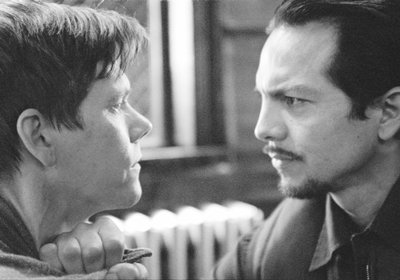“The Woodsman” bravely tackles child sex abuse
Tackling pedophilia on film is risky, and everything about Nicole Kassell’s “The Woodsman” involves risk—from its subject matter to its star casting including its Christmas Eve opening. Audiences are not used to the pedophile being portrayed as a flawed human being; we’re used to hyperbolic monsters emerging from dark shadows backed by the requisite sinister music.
Released from prison after 12 years, sex offender Walter (Kevin Bacon) is returned to society. He takes a job in a lumberyard in an unnamed city, and finds an apartment across from an elementary school playground. During the opening credits, we are informed of Walter’s status, and that he needs to check in regularly with a therapist and a parole officer. He is also told he will be paid impromptu visits by a police officer from time to time.
Walter attempts to closet his past during his re-entry into life. Almost immediately, at work, inquisitive co-worker Mary Kay (Eve) tries to befriend him, but gets inquisitive when Walter tries to keep a low profile. Their boss (David Alan Stiers) tells her to mind her own business.
Walter is also visited early on by Carlos, his brother-in-law (Benjamin Bratt), who is trying to act like all is well even though it’s clear that Walter’s sister is uncomfortable with his release, and will not allow Walter to see his 12-year-old niece any time soon.
At work, Walter befriends Vicki (Kyra Sedgwick, Bacon’s real-life wife), who is taunted by her blue-collar co-workers but successfully holds her ground. The two soon become lovers, and Vicki tells Walter she was molested by her three brothers.
Walter’s rehabilitation is not easy, as someone at work starts leaving telling warnings in his locker. The visits from Sgt. Lucas (Mos Def) seem more accusatory than helpful, and his sessions with the therapist don’t go well either. You are left wondering if Walter had any kind of therapy in 12 years of imprisonment.
The pressure at work eventually erupts, his secret exposed when Mary Kay decides “people have the right to know,” and the court of public opinion is not in his favor; in fact, it could get him killed.
At about this time, Walter spots a young girl on the bus ride home and follows her into the park. They strike up a friendship and the girl, Robin, tells him about all the birds she’s spotted in the park. During a second meeting, Walter makes a sexual overture that reveals that Robin, despite her seeming innocence, is wise to the ways of adults’ machinations. As Robin, Hannah Pilkes turns in quite a performance, and the encounter alters the way audiences will think about Walter.
Based on a play by the same name by Steven Fechter, who co-wrote the screenplay with director Kassell, this adaptation excels because the camera is able to make this story of compulsion and redemption immediate and intense. Kassell uses many close-ups, and an almost-grainy film style that gives the story a realism that would be undone by typical studio lighting and make-up. Kassell is also blessed with a dream cast. Bacon, Sedgwick, Bratt, Stiers, Mos Def, and Eve seem taut and intense throughout.
One motif Kassell repeats with effect is that of bird watching. Walter sets up a feeder and admires the winged creatures from his window. When Walter and Robin admire birds during their talks in the park, there’s a palpable feeling of envy—it’s as if they wish they led the carefree lives of birds and had the ability to soar above dangers of human desire.
More than anything else, “The Woodsman” is a tale about coping. Sedgwick points out that “sometimes you fall in love with someone because your damaged pieces fit.” Love and forgiveness prove to be powerful, transformative forces in Walter’s very damaged life. Kassell and Fechter don’t come up with answers, but they shed light on a family problem that is also a national epidemic, without resorting to easy demonization.
With one in four among us molested as children, it’s clear that incarceration alone has not solved the problem.


































